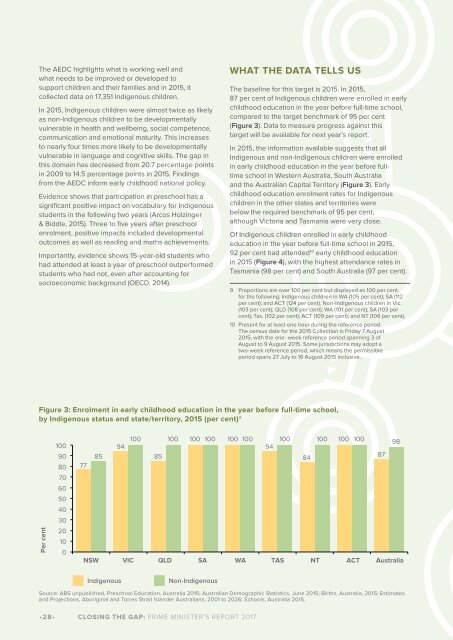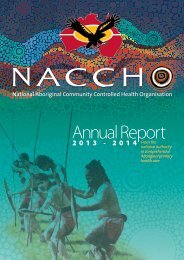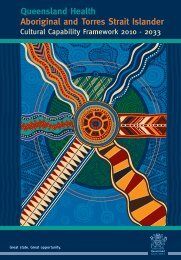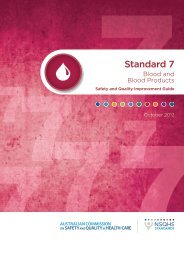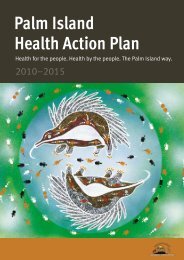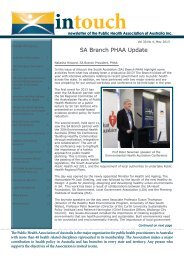CLOSING THE GAP
ctg-report-2017
ctg-report-2017
You also want an ePaper? Increase the reach of your titles
YUMPU automatically turns print PDFs into web optimized ePapers that Google loves.
The AEDC highlights what is working well and<br />
what needs to be improved or developed to<br />
support children and their families and in 2015, it<br />
collected data on 17,351 Indigenous children.<br />
In 2015, Indigenous children were almost twice as likely<br />
as non-Indigenous children to be developmentally<br />
vulnerable in health and wellbeing, social competence,<br />
communication and emotional maturity. This increases<br />
to nearly four times more likely to be developmentally<br />
vulnerable in language and cognitive skills. The gap in<br />
this domain has decreased from 20.7 percentage points<br />
in 2009 to 14.5 percentage points in 2015. Findings<br />
from the AEDC inform early childhood national policy.<br />
Evidence shows that participation in preschool has a<br />
significant positive impact on vocabulary for Indigenous<br />
students in the following two years (Arcos Holzinger<br />
& Biddle, 2015). Three to five years after preschool<br />
enrolment, positive impacts included developmental<br />
outcomes as well as reading and maths achievements.<br />
Importantly, evidence shows 15-year-old students who<br />
had attended at least a year of preschool outperformed<br />
students who had not, even after accounting for<br />
socioeconomic background (OECD, 2014).<br />
WHAT <strong>THE</strong> DATA TELLS US<br />
The baseline for this target is 2015. In 2015,<br />
87 per cent of Indigenous children were enrolled in early<br />
childhood education in the year before full-time school,<br />
compared to the target benchmark of 95 per cent<br />
(Figure 3). Data to measure progress against this<br />
target will be available for next year’s report.<br />
In 2015, the information available suggests that all<br />
Indigenous and non-Indigenous children were enrolled<br />
in early childhood education in the year before fulltime<br />
school in Western Australia, South Australia<br />
and the Australian Capital Territory (Figure 3). Early<br />
childhood education enrolment rates for Indigenous<br />
children in the other states and territories were<br />
below the required benchmark of 95 per cent,<br />
although Victoria and Tasmania were very close.<br />
Of Indigenous children enrolled in early childhood<br />
education in the year before full-time school in 2015,<br />
92 per cent had attended 10 early childhood education<br />
in 2015 (Figure 4), with the highest attendance rates in<br />
Tasmania (98 per cent) and South Australia (97 per cent).<br />
9 Proportions are over 100 per cent but displayed as 100 per cent<br />
for the following: Indigenous children in WA (105 per cent); SA (112<br />
per cent); and ACT (124 per cent). Non-Indigenous children in Vic.<br />
(103 per cent); QLD (108 per cent); WA (101 per cent); SA (103 per<br />
cent); Tas. (102 per cent); ACT (109 per cent); and NT (106 per cent).<br />
10 Present for at least one hour during the reference period.<br />
The census date for the 2015 Collection is Friday 7 August<br />
2015, with the one- week reference period spanning 3 of<br />
August to 9 August 2015. Some jurisdictions may adopt a<br />
two-week reference period, which means the permissible<br />
period spans 27 July to 16 August 2015 inclusive.<br />
Figure 3: Enrolment in early childhood education in the year before full-time school,<br />
by Indigenous status and state/territory, 2015 (per cent) 9<br />
Per cent<br />
100<br />
90<br />
80<br />
70<br />
60<br />
50<br />
40<br />
30<br />
20<br />
10<br />
0<br />
100 100 100 100 100 100 100 100 100 100<br />
94<br />
94<br />
98<br />
85<br />
85<br />
84<br />
87<br />
77<br />
NSW VIC QLD SA WA TAS NT ACT Australia<br />
Indigenous<br />
Non-Indigenous<br />
Source: ABS unpublished, Preschool Education, Australia 2015; Australian Demographic Statistics, June 2015; Births, Australia, 2015; Estimates<br />
and Projections, Aboriginal and Torres Strait Islander Australians, 2001 to 2026; Schools, Australia 2015.<br />
•28• <strong>CLOSING</strong> <strong>THE</strong> <strong>GAP</strong>: PRIME MINISTER'S REPORT 2017


